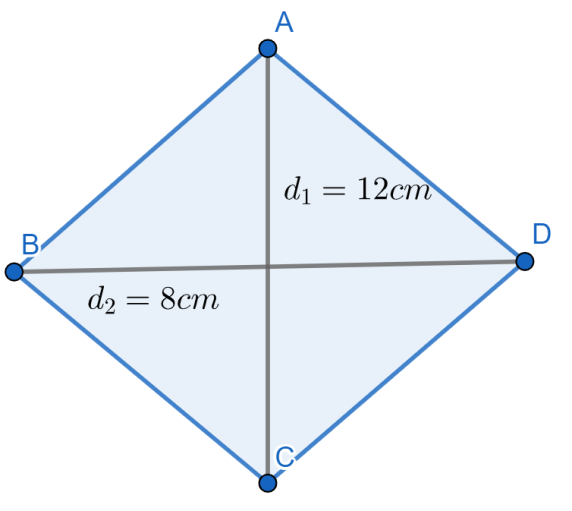
How do you find the area of a rhombus with diagonal lengths of $12cm$ and $8cm$ ?
Answer
536.4k+ views
Hint: In this question we have been asked to find the area of a rhombus using the given diagonal lengths $12cm$ and $8cm$ . For that we will use a formula from the basic concept to find the area of the rhombus is mathematically given as $\dfrac{1}{2}{{d}_{1}}{{d}_{2}}$.
Complete step by step solution:
Now considering from the question we have been asked to find the area of a rhombus using the given diagonal lengths $12cm$ and $8cm$ .
For doing that from the basic concepts we are aware of a formula for finding the area of the rhombus which is mathematically given as $\dfrac{1}{2}{{d}_{1}}{{d}_{2}}$ .

Now we will use this formula for solving this question. By applying we will have
$\dfrac{1}{2}{{d}_{1}}{{d}_{2}}=\dfrac{1}{2}\left( 12 \right)\left( 8 \right)$ .
By simplifying this expression further we will have $\dfrac{1}{2}\left( 12 \right)\left( 8 \right)=6\times 8$ .
Therefore we can conclude that the area of a rhombus with diagonal lengths of $12cm$ and $8cm$ is given as $48c{{m}^{2}}$ .
Note: Here we should be sure with our calculations we perform and concepts we apply while solving this question. If we are aware of the formulae then we can solve this question very easily in a short span of time and very few mistakes are possible. Similarly we can find the area of any rhombus using this formula even we can find the area of rhombus when we have length of the sides by using the Pythagoras theorem which states that “In a right triangle, the square of the length of the largest (hypotenuse) side is equal to the sum of the squares of the other two adjacent sides.”
Complete step by step solution:
Now considering from the question we have been asked to find the area of a rhombus using the given diagonal lengths $12cm$ and $8cm$ .
For doing that from the basic concepts we are aware of a formula for finding the area of the rhombus which is mathematically given as $\dfrac{1}{2}{{d}_{1}}{{d}_{2}}$ .

Now we will use this formula for solving this question. By applying we will have
$\dfrac{1}{2}{{d}_{1}}{{d}_{2}}=\dfrac{1}{2}\left( 12 \right)\left( 8 \right)$ .
By simplifying this expression further we will have $\dfrac{1}{2}\left( 12 \right)\left( 8 \right)=6\times 8$ .
Therefore we can conclude that the area of a rhombus with diagonal lengths of $12cm$ and $8cm$ is given as $48c{{m}^{2}}$ .
Note: Here we should be sure with our calculations we perform and concepts we apply while solving this question. If we are aware of the formulae then we can solve this question very easily in a short span of time and very few mistakes are possible. Similarly we can find the area of any rhombus using this formula even we can find the area of rhombus when we have length of the sides by using the Pythagoras theorem which states that “In a right triangle, the square of the length of the largest (hypotenuse) side is equal to the sum of the squares of the other two adjacent sides.”
Recently Updated Pages
Master Class 12 Business Studies: Engaging Questions & Answers for Success

Master Class 12 Economics: Engaging Questions & Answers for Success

Master Class 12 English: Engaging Questions & Answers for Success

Master Class 12 Maths: Engaging Questions & Answers for Success

Master Class 12 Social Science: Engaging Questions & Answers for Success

Master Class 12 Chemistry: Engaging Questions & Answers for Success

Trending doubts
Which places in India experience sunrise first and class 9 social science CBSE

Fill the blanks with the suitable prepositions 1 The class 9 english CBSE

Write the 6 fundamental rights of India and explain in detail

Difference Between Plant Cell and Animal Cell

What is the Full Form of ISI and RAW

Golden Revolution is related to AFood production BOil class 9 social science CBSE





